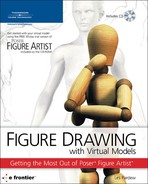Drawing from the Inside Out
At the beginning of every figure drawing, the artist is faced with a daunting task in defining a subject that is painfully complex yet supremely organized. Without initially simplifying the figure, the artist may become overwhelmed.
It is very important in the initial stages of a figure drawing to be able to use some kind of simple framework to define the dimensions and proportions of the figure on the paper. The artist needs a simple and accurate system for starting the figure on paper without getting bogged down in too much detail. One way of doing this that works well for me is to go back to the foundation of the figure itself and draw a simplified skeletal structure. Figure 2.1 shows a simplified skeleton; notice that it isn’t too much more complex than a simple stick figure.
Figure 2.1. Use a simplified skeleton like the one shown here to start your drawing.

The simplified skeleton should be proportionally correct, as shown in Figure 2.2, where I have overlaid the same proportion chart used in Chapter 1.
Figure 2.2. Make your skeleton the correct proportions.

This simplified figure is very useful in roughing out figures and figuring out compositions. It is easy to draw and doesn’t get bogged down in detail. Here is an example of how you can use it in conjunction with Figure Artist.
Step-by-Step
|
The skeleton that you just drew should fit over the top of the figure, as shown in Figure 2.9. In fact, a useful exercise for beginning artists is to use a piece of tracing paper and define the skeleton of photographs from magazines and other sources.
Figure 2.9. The skeleton and figure should match up with each other.

The nice part about drawing the skeleton first is that you can use it to create a number of very expressive figures in very little time.






